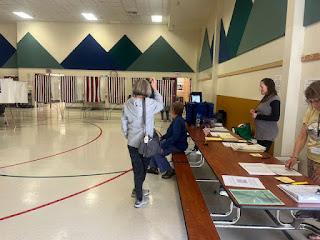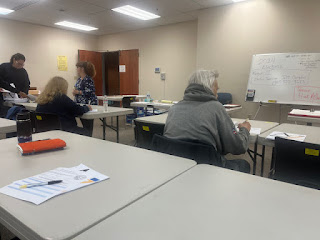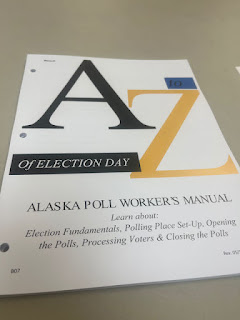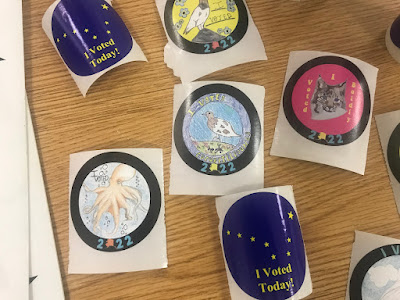One reason I haven't blogged as much as usual: I'm still having problems loading photos from my to my laptop. After I chatted with an Apple (allegedly a real person in the Philippines), I got it to work. But the very next time it didn't again. Also we were in LA and San Diego for a memorial for a high school friend. I could have done some quick photo posts, but . . . the airdrop wasn't dropping. And yes, I could probably load them onto the blog all on the phone, but I haven't tried doing that.
So Tuesday evening, I brought my Canon camera to the Marston Auditorium to hear about the SAVE Act - presented by the ACLU, the League of Women's Voters, and the Native American Fund. That camera has an SD card and I have an attachment that lets me plug it into the laptop.
What he didn't say, in so many words, but what I took from all the specific issues, was that this is a giant voter suppression act. Which makes sense coming from this administration and, presumably, the folks at the Heritage Foundation. They've been worried about the changing US demographics for years. It's why they talk about The Great Replacement Theory. And some folks said 2024 was the last year demographics gave the Republicans a chance to win elections. Which is why, in part, the president is trying to export a million people. And import white South Africans. I'd note that voting by non-citizens is rare, but Republicans seem to want to make people believe it's common, just as they want to make people believe most immigrants are here illegally, are rapits, terrorists, and or murderers. All to justify flying kidnapped people (citizens and non-citizens) to gulags outside the US. But this is all my take, not what Xavier said.
 |
| Xavier Presad |
- birth certificate
- passport
 |
| The panel after Prasad's talk |
 |
| Panelist Kristen Gerbatsch, Native American Rights Fund |
Section 4 CongressClause 1 Elections ClauseThe Times, Places and Manner of holding Elections for Senators and Representatives, shall be prescribed in each State by the Legislature thereof; but the Congress may at any time by Law make or alter such Regulations, except as to the Places of chusing Senators."
Congress has the power to make changes.
But the bill doesn't authorize any funding for the massive changes states will have to make to the ways they register voters, check for proof of citizenship, and training for staff and poll workers on all the new regulations. I couldn't find a cost estimate, though I believe one of the speakers did give one.
 |
| Panelist Riza Smith, Action Alaska, Vet |
 |
| Kayak ad for Anchorage to Dutch Harbor flight $1408 round trip |
From the SAVE Act as of April 10, 2025 after passage in the House:(1) A form of identification issued consistent with the requirements of the REAL ID Act of 2005 that indicates the applicant is a citizen of the United States.
(2) A valid United States passport.
(3) The applicant's official United States military identification card, together with a United States military record of service showing that the applicant's place of birth was in the United States.
(4) A valid government-issued photo identification card issued by a Federal, State or Tribal government showing that the applicant’s place of birth was in the United States.
(5) A valid government-issued photo identification card issued by a Federal, State or Tribal government other than an identification described in paragraphs (1) through (4), but only if presented together with one or more of the following:
(A) A certified birth certificate issued by a State, a unit of local government in a State, or a Tribal government which—
(i) was issued by the State, unit of local government, or Tribal government in which the applicant was born;
(ii) was filed with the office responsible for keeping vital records in the State;
(iii) includes the full name, date of birth, and place of birth of the applicant;
(iv) lists the full names of one or both of the parents of the applicant;
(v) has the signature of an individual who is authorized to sign birth certificates on behalf of the State, unit of local government, or Tribal government in which the applicant was born;
(vi) includes the date that the certificate was filed with the office responsible for keeping vital records in the State; and
(vii) has the seal of the State, unit of local government, or Tribal government that issued the birth certificate.
(B) An extract from a United States hospital Record of Birth created at the time of the applicant's birth which indicates that the applicant’s place of birth was in the United States.
(C) A final adoption decree showing the applicant’s name and that the applicant’s place of birth was in the United States.
(D) A Consular Report of Birth Abroad of a citizen of the United States or a certification of the applicant’s Report of Birth of a United States citizen issued by the Secretary of State.
(E) A Naturalization Certificate or Certificate of Citizenship issued by the Secretary of Homeland Security or any other document or method of proof of United States citizenship issued by the Federal government pursuant to the Immigration and Nationality Act.
(F) An American Indian Card issued by the Department of Homeland Security with the classification ‘KIC’.
Appendix 2: State Requirements in the Act
State requirements [this is only partial]
Each State shall take affirmative steps on an ongoing basis to ensure that only United States citizens are registered to vote under the provisions of this Act, which shall include the establishment of a program described in paragraph (4) not later than 30 days after the date of the enactment of this subsection.
Program described
A State may meet the requirements of paragraph (3) by establishing a program under which the State identifies individuals who are not United States citizens using information supplied by one or more of the following sources:
The Department of Homeland Security through the Systematic Alien Verification for Entitlements (SAVE
) or otherwise.
The Social Security Administration through the Social Security Number Verification Service, or otherwise.
State agencies that supply State identification cards or driver’s licenses where the agency confirms the United States citizenship status of applicants.
Other sources, including databases, which provide confirmation of United States citizenship status.


















